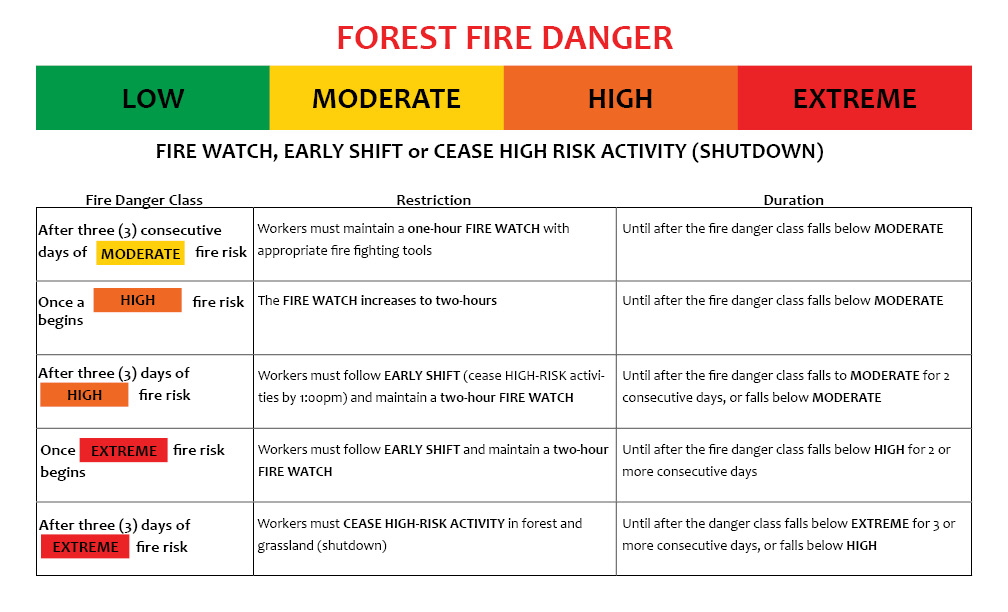Reducing wildfire risk
Wildfires can start and spread quickly. Learn how you can reduce the risk of wildfires, and what you can and can't do during higher-risk forest fire danger periods.
The following "cheat sheet" explains each high-risk hazard:
High-risk activities
- Mechanical brushing.
- Disk trenching.
- Preparation or use of explosives (e.g. fireworks, blasting).
- Using fire- or spark-producing tools, including cutting tools (e.g. grinders, cutting torches)
- Using or preparing fireworks or pyrotechnics; (e.g. fireworks, blasting)
- Grinding, including rail grinding.
- Mechanical land clearing (e.g. excavator, skidder)
- Clearing and maintaining rights of way, including commercial right of way grass mowing (residential lawn mowing is not included)
- Any of the following activities carried out in a cut block, excluding a road, landing, roadside work area or log sort area in the cut block:
- Operating a power saw (unless on a landing)
- Mechanical tree felling, woody debris piling or tree processing, including de-limbing
- Welding.
- Portable wood chipping, milling, processing or manufacturing (unless on a landing)
- Skidding logs or log forwarding unless it is improbable that the skidding or forwarding will result in the equipment contacting rock.
- 6- Yarding logs using cable systems.
What is Early Shift and when does it start?
- Early Shift means all high-risk activities must stop by 1 p.m.
- After three consecutive days of HIGH, all high-risk activities must cease by 1 p.m.
- After three consecutive days of EXTREME, cease all activities.
What are the responsibilities of a Fire Watcher?
A Fire Watcher:
- Can reasonably see the site of the high-risk activity during the time the fire watcher is required.
- Has at least one firefighting hand tool.
- Actively watches and patrols for sparks and fires on the site of the high risk activity.
- Immediately carries out fire control and extinguishes the fire, if practicable.
- Has the means on site to report the fire (landline or cellular).
Frequently Asked Questions - High-risk activity
Questions
Answers
-
Can I mow my lawn?
Yes. Residents can use their lawnmowers for cutting their lawns. If the lawn is green and requires cutting, and has been irrigated, it is fire resistant. If residents want to mow their lawn when it is dry and dead, we recommend holding off or using preventative measures such as pre wet and post wet lawn; and remain on site after mowing to watch out for smoldering fires. Have fire suppression available (garden hose) and a way to contact 9-1-1 if need be.
-
Can I use a weed eater?
Yes. Same principles as lawn mowing, but extra precautions should be discussed with the fire department if using metal disk blades.
-
Can farmers hay their hay fields?
Yes. However, during shut down there may be special fire prevention measures required. If not a critical job, we suggest holding off haying until the fire danger decreases. There are irrigated fields that are fairly safe to hay even in Extreme conditions.
-
Is excavating a high-risk activity?
No - as long as the excavation is being done on rock, dirt or mineral soil. Examples of excavating could be construction sites, septic tank, driveway work, etc… Excavating doesn’t include land clearing.
-
Can I use a chainsaw on a landing?
Yes. Chainsaw use is only permitted on non-combustible surfaces during shutdown. (Surfaces such as green grass, gravel, dirt, roadway)
-
Is drilling a high-risk activity?
No. Contractors can drill in rock under no restrictions. Blasting is only permitted in early shift or regular shift. No Blasting is permitted during “SHUT DOWN”
-
What is the local fire hazard, what do they mean, and how is it determined?
Low: Fires may start easily and spread quickly but there will be minimal involvement of deeper fuel layers or larger fuels.
Moderate: Forest fuels are drying and there is an increased risk of surface fires starting. Carry out any forest activities with caution.
High: Forest fuels are very dry and the fire risk is serious. New fires may start easily, burn vigorously, and challenge fire suppression efforts. Extreme caution must be used in any forest activities. Open burning and industrial activities may be restricted.
Extreme: Extremely dry forest fuels and the fire risk is very serious. New fires will start easily, spread rapidly, and challenge fire suppression efforts. General forest activities may be restricted, including open burning, industrial activities and campfires.
Community members can also use these information signs to guide best practices for their own forest-use activities. Burn Restrictions may also be posted alongside the Local Fire Hazard regarding use of land clearing, backyard burning and campfires.
